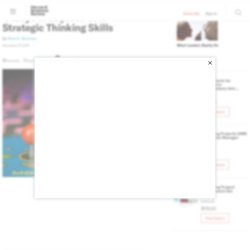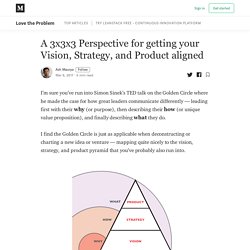

4 Ways to Improve Your Strategic Thinking Skills. Executive Summary If you believe that strategic thinking is only for senior executives, think again.

It can, and must, happen at every level of the organization; it’s one of those unwritten parts of all job descriptions. Once you’ve accepted that it’s part of your job, focus on developing four key abilities that demonstrate your strategic prowess. First, routinely explore the internal trends in your daily work, like issues that come up repeatedly. The second ability is asking tough questions: “What does success look like in Year 1? This Advice From IDEO's Nicole Kahn Will Transform the Way You Give Presentations.
“Stories are the way our teams get excited, aligned, and rallied around the same goal,” says long-time IDEO Project Lead Nicole Kahn.

“But more importantly, we know that our designs don’t live on with our clients without a good story attached to them. This is something we wanted to shift — to ensure that all of our designers would also see themselves as storytellers.” Kahn, along with a team of fellow storytellers, has helped champion this philosophy through events they've held at IDEO offices across the country. The goal: to provide a model for what good presentations look like, while also giving designers a chance to talk about what inspires their creativity, and get solid feedback from an audience of their peers. At First Round’s recent Design+Startup event, Kahn shared lessons she and her teammates have compiled, which have become a set of best practices for giving high-impact presentations. Run the Bar Test Build Your Skeleton Less Words, More Visuals. This Advice From IDEO's Nicole Kahn Will Transform the Way You Give Presentations.
A 3x3x3 Perspective for getting your Vision, Strategy, and Product aligned. I’m sure you’ve run into Simon Sinek’s TED talk on the Golden Circle where he made the case for how great leaders communicate differently — leading first with their why (or purpose), then describing their how (or unique value proposition), and finally describing what they do.

I find the Golden Circle is just as applicable when deconstructing or charting a new idea or venture — mapping quite nicely to the vision, strategy, and product pyramid that you’ve probably also run into. The mistake too many entrepreneurs make is rushing up this pyramid and prematurely falling in love with their product. This is the classic build-first or solution-first approach where the tendency is to lead with what you are building (product) instead of taking the requisite time needed to first get your vision (why) and strategy (how) in order. Vision and strategy are foundational pieces without which even a good product cannot withstand the weight of its market.
Forging Honor: Providing a Coherent Vision for a New IP. Tim Brown: Designers. Your Strategy Has to Be Flexible — But So Does Your Execution. Executive Summary Strategy execution should be as varied, as thoughtful, as subtle, as diverse and as intertwined with the strategy itself as is necessary to get the job done.

But all too often, executives fail to execute a strategy because they’re oversimplifying its execution. Some fall into a trap of excessive complexity, which can undermine thoughtful execution as much as a failure to specify tactics. Busyness can become an implicit goal or cultural norm, and the original strategic intent can be lost in a frenzy of detail and activity. Emphasizing compliance with a plan can, under stable conditions, accelerate fruition of a strategy.
Peter Drucker said: “Plans are only good intentions unless they immediately degenerate into hard work.” In fact, several frequently observed traps result from such a view of execution: Designing for Entertainment - Industry Workshops - Mike Hill. The incredible inventions of intuitive AI. Carmine Gallo: "The Storytellers Secret" How Much Time Does It Take to Create Personas? 16 trends that will define the future of video games. Hundreds of game developers, publishers and analysts recently descended on Brighton for the annual Develop conference.

There were controversial keynotes, there were talks about how to make money in a rapidly fragmenting marketplace, but there were also some interesting forward-looking sessions, concerned with where the games industry as a whole is heading – not so much in terms of game design (that’s the domain of events like the Game Developers Conference and SXSW), more in the way the sector will operate as a business.
Some of it is pretty weird. Here, then, are the major trends that we picked up on, all of which could completely change the way games are made – and played – in the near future. 1. Parents as gaming advocates At the same time, families are spending more time together in the living room, with a reduction in the number of children with TVs in their rooms. 2. 360 degrees of freedom This won’t be confined to family brands. What Team Centered Goal Setting Really Looks Like — StackStreet.
An Anti-Creativity Checklist for 2015. Learn to Think Long-Term Like Jeff Bezos. Seth Godin: How to get your ideas to spread. Harvard Bonin's Blog - In Search of Bigfoot (The eight elusive phases of game development) The following blog post, unless otherwise noted, was written by a member of Gamasutra’s community.

The thoughts and opinions expressed are those of the writer and not Gamasutra or its parent company. I believe that there’s an idyllic roadmap for all game development. It can apply to all manner of projects. All small, large, mobile, console, PC, etc. game projects can be fit into this utopian archetype. I call it the “Bigfoot Model of Phased Development”. Steve Jobs On Value Of Ideas.